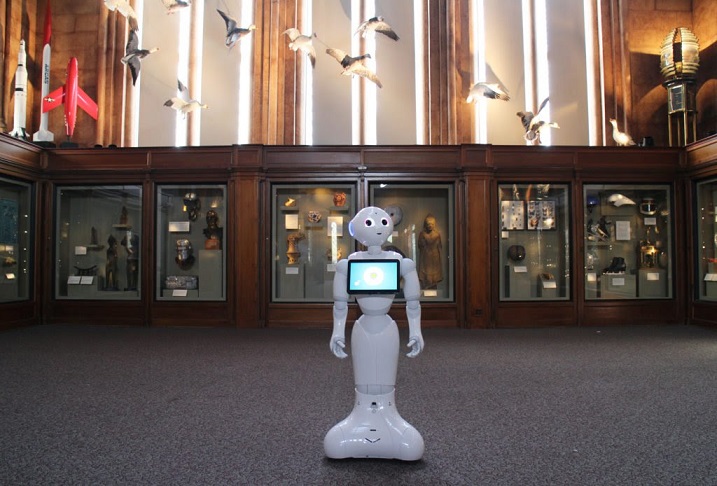Museums must compete harder than ever to attract attention in our smartphone-dazed world, and many are turning to technology to draw people through the door. This week, the Smithsonian Institution in Washington, DC, unveiled the latest attention-getting gadget: a four-foot-tall interactive robot named Pepper.
Motoring around several galleries across the Smithsonian complex, Pepper answers questions, tells stories, dances, and even poses for selfies. And so far it’s been a big hit.
“Whenever we put Pepper on the floor there is a continuous stream of people around it,” says Rachel Rachel Goslins, the director of the Arts and Industries building that led the development of Pepper’s program. “It attracts a crowd, from super young kids who want to hug it to older people who use it as a tool for digging deeper into the information they’re curious about.”

Pepper the Robot. Courtesy of the Smithsonian Institution.
Pepper is the product of Softbank, one of the world’s leading humanoid robotics manufacturers. The company donated 30 robots to the museum last year, and has since agreed to provide 100 more. Six of those have been introduced into five of the Smithsonian’s branches: the National Museum of African Art, the National Museum of African American History and Culture, the Hirshhorn Museum, the Smithsonian Castle, and the Smithsonian Environmental Research Center.
So far, each museum has used Pepper a little differently. The National Museum of African Art has tasked the robot with translating Swahili for visitors attending the new “World on the Horizon: Swahili Arts Across the Indian Ocean” exhibit. The Hirshhorn, meanwhile, has paired Pepper with docents, helping visitors to better understand the work on display. And the Environmental Research Center is letting local high school students practice computer programming on Pepper.
Eventually, Pepper robots will be incorporated into nearly all 19 museums and nine research centers. Its functionality will also improve with new software upgrades, but it’s important that Pepper’s limits remain in place, Goslins says.

Rachel Goslins. Photo: Blink Photography. Courtesy of the Smithsonian Institution.
“As museum professionals, there’s a temptation to chase new technologies as the answer to staying relevant and feeling contemporary and getting those millennials in the door,” she says. “It’s easy to confuse a strategy with a tool, though. Technology is just a tool; if it’s not solving a problem, then it’s just a gimmick.”
There’s a risk of distracting people from the very experiences they are meant to facilitate, for example. The question for museums administrators, Goslins says, is “How do we not take people out of our museums once we get them in there?”
“One of the challenges with these new forms of museum technologies is that many of them are quite isolating—you’re looking at your phone as you interact with an app, you have earbuds in because you’re listening to a geo-located audio tour, or you’re literally putting on a pair of goggles to disappear into your own world,” Goslins says. “So far, the experience with Pepper has been much more interactive and social than some of these other technologies. Visitors are able to engage with it but it doesn’t take them away from the moment.”


